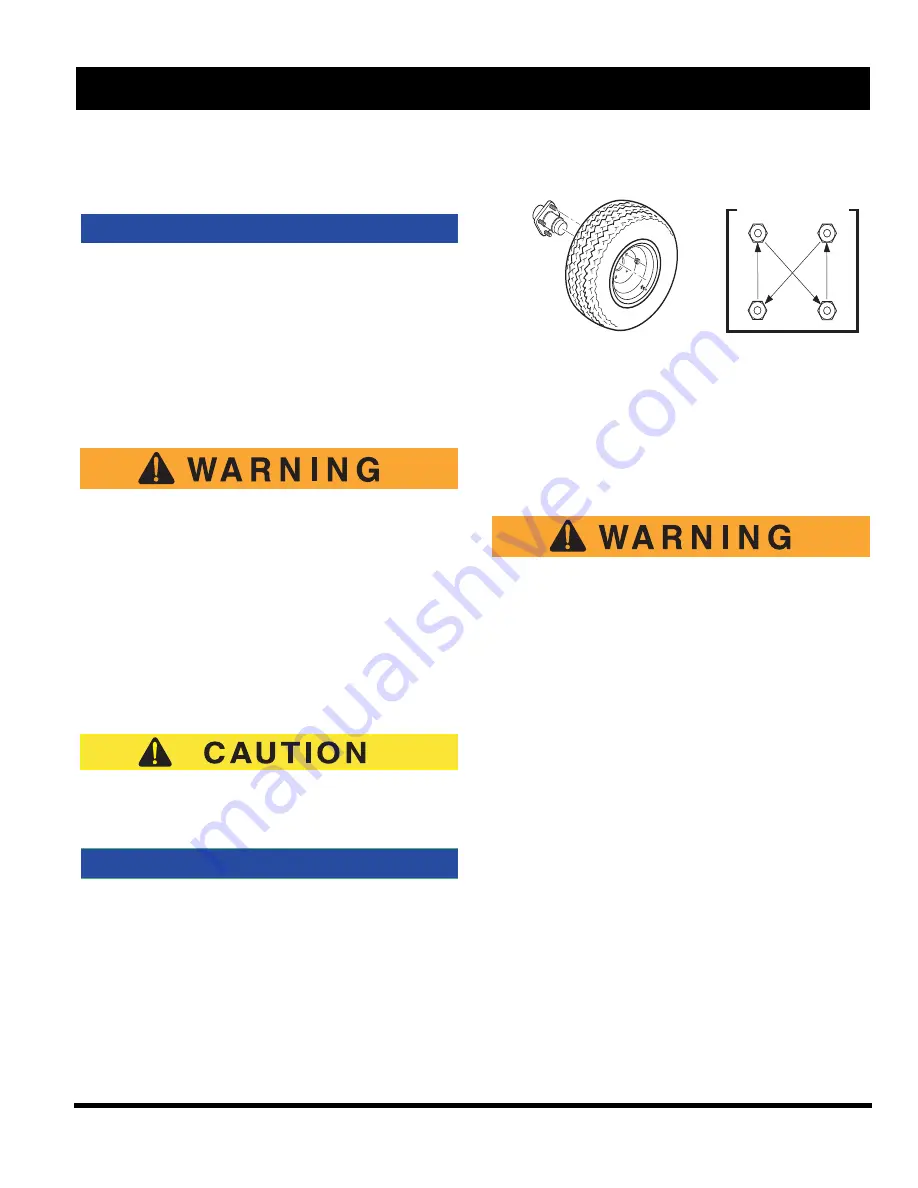
OPERATION AND SERVICE INFORMATION
Page 9
Owner’s Manual and Service Guide
Read all of Manual to become thoroughly familiar with this vehicle. Pay particular attention to all Notices, Cautions, Dangers and Warnings
effective way to repair a puncture in the tread is to use a
commercial tire plug.
Tire plug tools and plugs are available at most automotive parts
outlets and have the advantage of not requiring the tire be
removed from the wheel.
If the tire is flat, remove the wheel and inflate the tire to
the maximum recommended pressure for the tire.
Immerse the tire in water to locate the leak and mark with
chalk. Insert tire plug in accordance with manufacturer’s
instructions.
To reduce possibility of severe injury, be sure
mounting/demounting machine is anchored to
floor. Wear OSHA approved safety equipment
when mounting/demounting tires.
If the tire is to be removed or mounted, the tire changing
machine manufacturer’s recommendations must be fol-
lowed in order to reduce possibility of severe injury.
Wheel Installation
To reduce the possibility of component damage, do not
tighten lug nuts to more than 85 ft. lbs. (115 Nm) torque.
It is important to follow the ‘cross sequence’ pattern when
installing lug nuts. This will assure even seating of the wheel
against the hub.
With the valve stem to the outside, mount the wheel onto
the hub with lug nuts. Finger tighten lug nuts in a ‘cross
sequence’ pattern (Ref Fig. 10 on page - 9). Tighten lug
nuts in the ’cross sequence’ pattern by torquing in 20 ft.
lbs. (30 Nm) increments following the ‘cross sequence’
pattern.
Fig. 10 Wheel Installation
VEHICLE WITH A DISCHARGED BATTERY
To reduce the possibility of severe injury or
death from inadvertent motion, do not attempt
to ‘jump start’ a vehicle.
The vehicle is equipped with a starter/generator and
does not idle. When starting the engine, the starter/gen-
erator functions as a starter and with the engine running,
it functions as a generator.
With the short running times associated with this kind of
vehicle, the generator is more than adequate to maintain
the battery charge level. The generator is not designed to
charge a discharged battery.
When engine starts, the clutches engage and cause
vehicle to move making ‘jump starting’ both dangerous
and impractical.
If the vehicle battery has become discharged, it must be
charged using a 12 volt charger that is rated at 10 amps
or less. Read all instructions provided by the manufac-
turer of the charger.
NOTICE
NOTICE
Tire style
may vary
1
2
3
4
'Cross Sequence'
Ref Whi 1
Summary of Contents for 614212 2010
Page 1: ...Owner s Manual Service Guide Issued February 2010 Revised August 2012...
Page 10: ...Owner s Manual and Service Guide Page viii SAFETY INFORMATION NOTES...
Page 35: ...Page 25 Owner s Manual and Service Guide GENERAL SPECIFICATIONS GENERAL SPECIFICATIONS...
Page 41: ...Appendix A 1 Owner s Manual and Service Guide LABELS AND PICTOGRAMS LABELS AND PICTOGRAMS...
Page 46: ...Appendix A 6 Owner s Manual and Service Guide LABELS AND PICTOGRAMS Notes...
Page 47: ...Appendix B 1 VEHICLE WARRANTIES Owner s Manual and Service Guide VEHICLE WARRANTIES...
Page 54: ...Appendix C 2 Owner s Manual and Service Guide DECLARATION OF CONFORMITY...
Page 55: ...Appendix C 3 DECLARATION OF CONFORMITY Owner s Manual and Service Guide...
Page 56: ...Appendix C 4 Owner s Manual and Service Guide DECLARATION OF CONFORMITY NOTES...






























